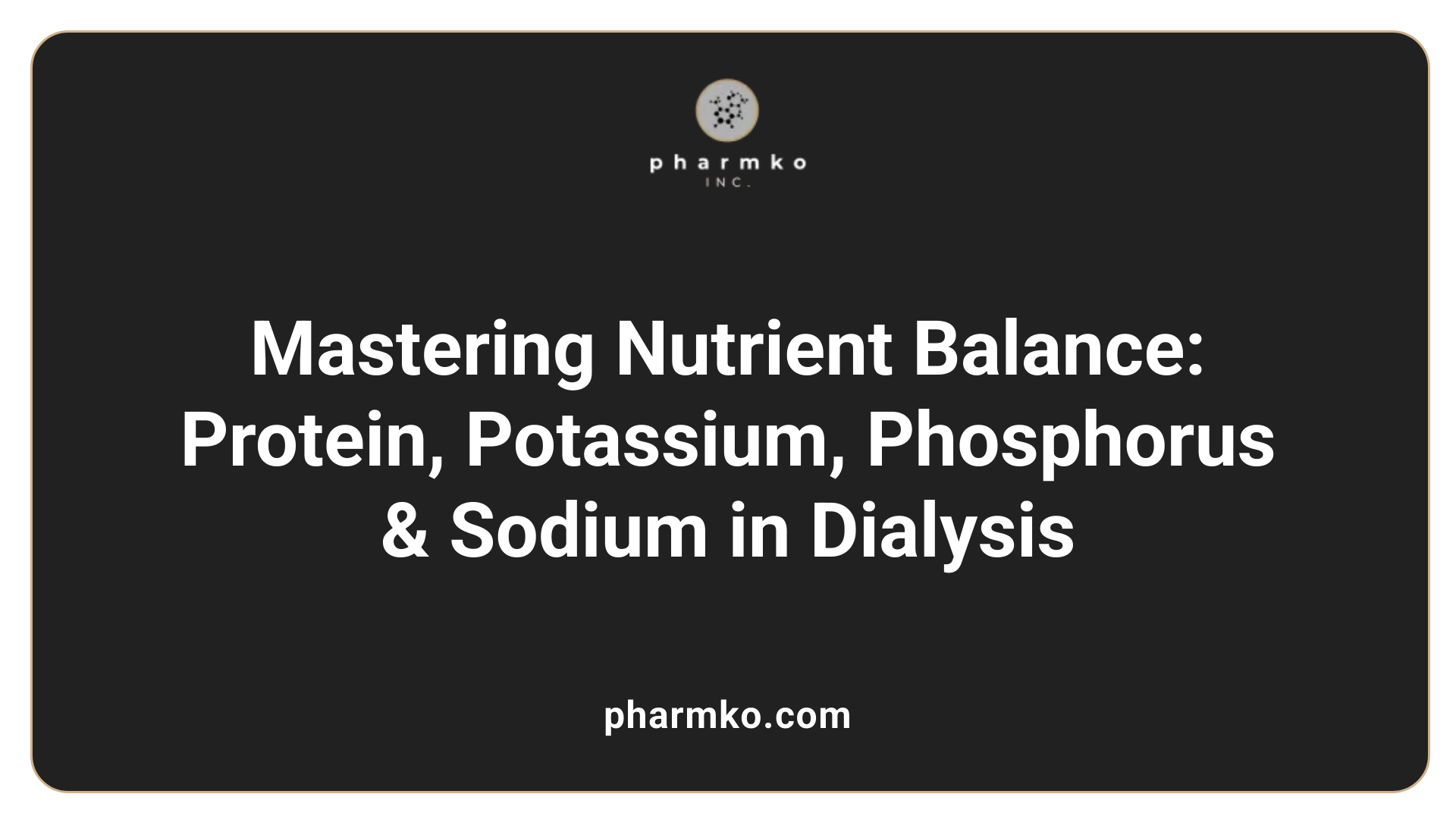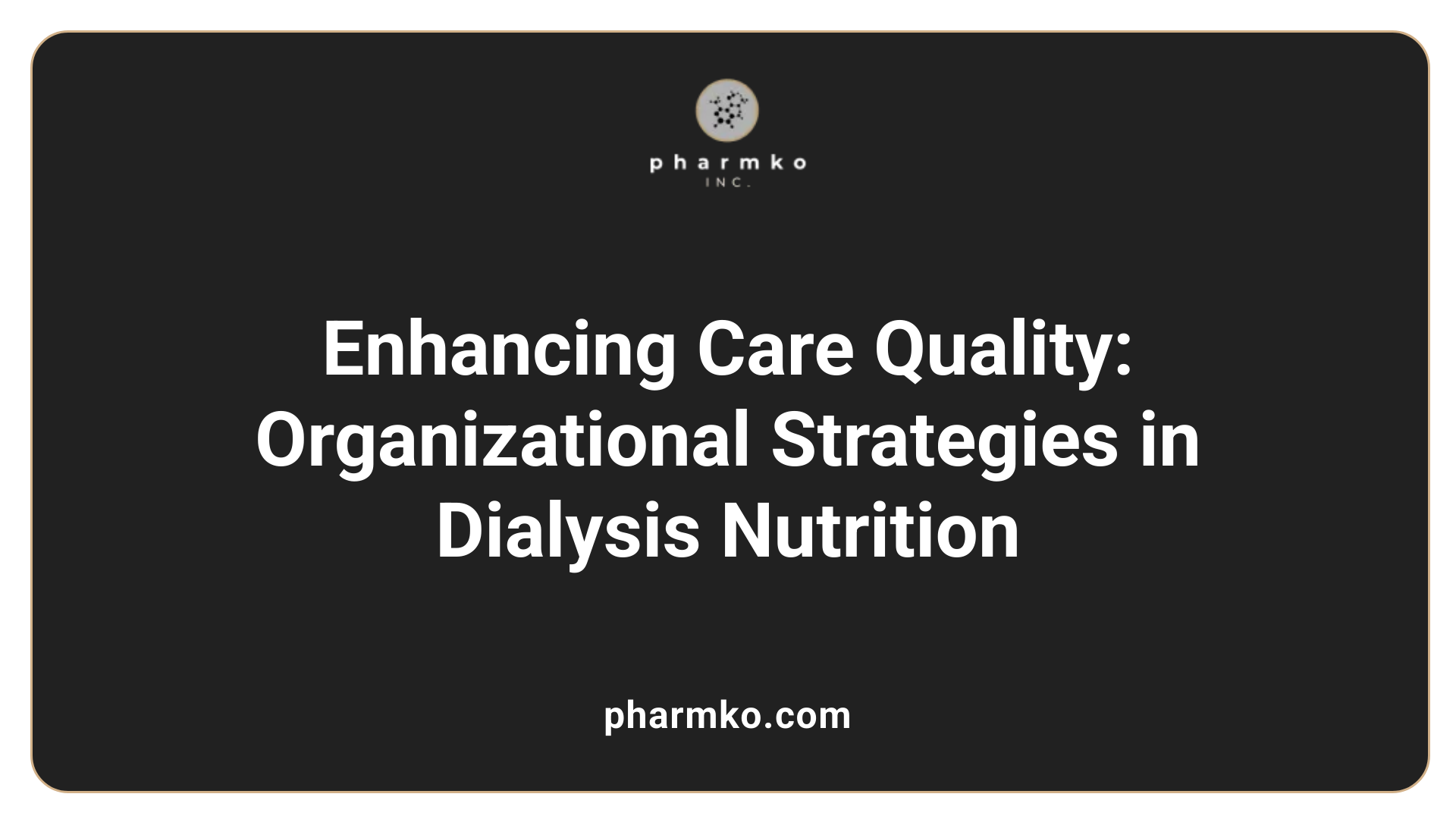Optimized nutrition for dialysis patients
Understanding the Critical Role of Nutrition in Dialysis Management
Optimal nutrition in dialysis patients is vital for managing waste buildup, electrolyte balance, and preventing malnutrition. Given the complex needs of individuals undergoing different dialysis modalities, personalized dietary planning guided by healthcare professionals—including renal dietitians—is essential to improve clinical outcomes, quality of life, and survival rates.
Core Principles of Nutritional Management in Dialysis Patients
What are the dietary considerations for patients on dialysis?
Patients undergoing dialysis face unique nutritional challenges that require careful dietary management. The primary goal is to reduce waste and excess fluid buildup in the bloodstream, which the kidneys would typically filter out. To achieve this, patients must adhere to a specialized diet tailored to their dialysis type and personal health needs.
A high-quality protein intake is essential because dialysis treatments can cause protein losses, leading to muscle wasting and malnutrition. Typically, patients are advised to consume lean meats, fish, eggs, and poultry, with guidance from a renal dietitian to ensure the right balance.
Controlling fluid intake is crucial to prevent swelling, high blood pressure, and other complications. Patients should monitor their daily fluid consumption, including liquids at room temperature such as gelatin or ice cream, as advised by their healthcare provider.
Electrolyte management is also vital. Potassium and phosphorus levels need close monitoring and restrictions to prevent dangerous conditions like hyperkalemia (which can cause serious heart issues) and hyperphosphatemia. Common high-potassium foods, such as bananas, oranges, and tomatoes, may be limited, and phosphorus-rich foods like dairy, organ meats, and processed foods should be avoided or restricted.
Limiting salt intake helps control blood pressure and fluid retention. Patients are encouraged to avoid processed foods and flavor dishes with herbs and spices instead of salt.
Working with healthcare professionals, particularly dietitians, is fundamental in developing a meal plan that balances the need to control waste and electrolyte levels while ensuring nutritional adequacy.
Overall, dialysis-specific nutrition requires a comprehensive approach to diet modification, fluid management, and nutrient monitoring to support patient health and improve treatment outcomes.
Dietary Guidelines and Restrictions for Dialysis Patients
What is the best diet for a dialysis patient?
For patients undergoing dialysis, maintaining a nutritious and balanced diet is crucial. The goal is to support their treatment, prevent complications, and improve overall quality of life.
A tailored approach involves managing intake of protein, fluids, and key electrolytes like potassium and phosphorus. High-quality protein sources such as meat, fish, eggs, and poultry are recommended because they help replace what is lost during dialysis and produce less nitrogenous waste, which the kidneys or dialysis have to clear.
Controlling phosphorus levels is essential to prevent bone disease and vascular calcification. This often involves limiting foods rich in phosphorus, such as dairy products, nuts, and processed foods, and using phosphate binders when necessary.
Fluid intake must be carefully monitored to avoid excess, which can cause swelling and high blood pressure. Patients are advised to measure and record their daily fluid consumption, including foods with high water content like soups, puddings, and fruits.
Potassium management is also vital, as excessive intake can lead to serious heart rhythm problems. Patients should limit high-potassium foods such as bananas, oranges, and spinach, especially if their blood levels are elevated.
Dietary restrictions are usually personalized and should be developed in close consultation with a renal dietitian. This approach ensures that each patient’s specific needs for calories, nutrients, and restrictions are met, helping to optimize treatment outcomes and support overall health.
By following these guidelines, dialysis patients can better manage their condition while maintaining adequate nutritional status.
Management of Nutrients: Protein, Potassium, Phosphorus, and Sodium

Why is potassium restriction important for dialysis patients?
Potassium regulation is vital for individuals on dialysis because their kidneys cannot effectively remove excess potassium from the bloodstream. Elevated potassium levels, known as hyperkalemia, can cause serious and potentially life-threatening cardiac issues such as arrhythmias and muscle weakness. In a healthy body, the kidneys help maintain potassium balance, but in dialysis patients, this function is impaired.
Foods high in potassium, such as bananas, oranges, spinach, and potatoes, need to be monitored carefully. Although these foods are nutritious for most people, they may pose risks for those with compromised kidney function. Managing potassium intake helps prevent hyperkalemia and ensures heart health by reducing the risk of abnormal heart rhythms.
Dietary restrictions and dialysis treatments work together to keep potassium levels within a safe range. This balanced approach is crucial to avoid complications like muscle failure and cardiac arrest. In addition to diet, medications like potassium binders may be used.
Proper monitoring of potassium levels through blood tests guides dietary choices and treatment adjustments. Ultimately, controlling potassium intake is a cornerstone of dietary management for dialysis patients, aimed at safeguarding heart health and preventing emergencies.
What is the 'rule of 7' in dialysis potassium management?
The 'rule of 7' is a practical guideline used during dialysis to manage potassium levels effectively. It involves adjusting the dialysate potassium concentration so that when added to the pre-dialysis blood potassium level, the total approximates 7 mEq/L, helping to stabilize potassium balance. By tailoring dialysate composition based on this rule, clinicians can mitigate rapid shifts in potassium and reduce the risk of arrhythmias.
This method provides a straightforward way to customize treatment, especially in cases where blood potassium levels are fluctuating. It highlights the importance of individualized care in dialysis settings.
Maintaining optimal potassium levels involves a combination of dietary management, medication, and precise dialysis adjustments like the 'rule of 7', ensuring patient safety and cardiovascular stability.
Addressing Protein-Energy Wasting (PEW) in Dialysis Patients

How to prevent and treat protein energy wasting (PEW) in dialysis patients?
PEW is highly common among patients with end-stage renal disease (ESRD) undergoing dialysis, significantly affecting morbidity and mortality. Managing PEW involves a multifaceted approach that integrates nutritional, medical, and dialysis strategies.
A cornerstone of treatment is ensuring adequate nutrient intake. Patients require a protein intake of more than 1.2 grams per kilogram of ideal body weight daily, with at least half of this coming from high biological value proteins such as animal and plant sources. Caloric intake should be maintained at about 30 to 35 kcal per kilogram of ideal body weight per day to prevent muscle wasting.
Nutritional supplementation plays a vital role when dietary intake alone fails. Oral supplements, including protein shakes, are effective, especially if taken during dialysis sessions. These interventions have been shown to improve serum albumin levels, body weight, lean muscle mass, and overall quality of life.
Addressing metabolic disturbances is equally important. Correcting metabolic acidosis with oral bicarbonate has been associated with better nutritional parameters. Additionally, new therapies like appetite stimulants such as ghrelin and anti-inflammatory measures are under investigation.
Overall, a tailored combination of dietary counseling, medical treatment, and dialysis management is essential to prevent and treat PEW, ultimately improving patient outcomes and quality of life.
Scientific Evidence and Research in Nutritional Management of Dialysis Patients

What are the latest research findings on nutrition in dialysis care?
Recent studies underscore the importance of tailored nutrition strategies for dialysis patients to optimize health outcomes. Evidence shows that protein restriction in non-dialysis CKD can effectively slow the progression of renal decline. Diets emphasizing plant-based proteins have been linked to renoprotective effects, including reductions in uremic toxins and potentially improved survival rates.
For patients undergoing dialysis, ensuring adequate intake of high-quality protein is critical. This helps replace proteins lost during treatment without exacerbating uremic symptoms. Research supports the use of oral nutritional supplements, such as protein shakes and snack boxes, particularly during dialysis sessions. These interventions have demonstrated improvements in serum albumin levels, weight, lean mass, and overall quality of life.
Emerging therapies are also on the horizon. Anti-inflammatory medications and appetite stimulants like ghrelin are being investigated to combat protein-energy wasting (PEW). The 2020 Kidney Disease Outcomes Quality Initiative (KDOQI) guidelines recommend individualized dietary plans that balance nutrient needs with electrolyte and waste management.
Overall, ongoing research continues to refine the understanding of optimal nutrition in dialysis patients, aiming to reduce morbidity and improve survival.
Educational Approaches for Patient Awareness of Dialysis Nutrition

How can education improve nutritional adherence in dialysis patients?
Nutritional education is fundamental in helping dialysis patients follow their dietary prescriptions effectively. When patients understand the influence of nutrition on their treatment, they are more likely to make compliant choices.
Clear information about managing intake of nutrients such as potassium, phosphorus, sodium, and fluids can reduce complications like hyperkalemia, hyperphosphatemia, and fluid overload. Teaching patients about kidney-friendly foods—such as fruits, vegetables, nuts, seeds, and high-quality proteins—empowers them to select suitable options.
Resource provision plays a critical role. Handouts, counseling sessions, and peer support groups provide continuous guidance and motivation. These tools can demystify complex dietary instructions, making adherence easier.
Monitoring and follow-up are also vital. Regular check-ins with healthcare providers, especially dietitians, help address individual barriers, such as hospital delays in meal provision or fasting issues, ensuring sustained compliance.
Ultimately, education enhances understanding of how diet influences health outcomes, encourages active participation in care, and supports the maintenance of nutritional status, which is crucial for the quality of life of dialysis patients.
Best Practices and Future Directions in Dialysis Nutritional Therapies
What are the recent advances in nutritional therapies for dialysis patients?
Recent developments in dialysis nutrition focus on customizing and enhancing interventions to better meet patient needs. Multidisciplinary teams involving dietitians, nephrologists, and nursing staff now craft more personalized diet plans that consider each patient's unique metabolic profile, comorbidities, and lifestyle.
One significant innovation is the use of targeted supplementation during dialysis sessions. Introducing nutrient-dense snacks, protein shakes, and oral nutritional supplements (ONS) has demonstrated improvements in serum albumin levels, body weight, and overall nutritional status.
Technology plays an increasing role in supporting adherence to dietary guidelines. Digital tools, mobile apps, and remote monitoring facilitate ongoing feedback and adjustments, making individualized plans more feasible.
Emerging therapies also aim to address specific challenges like protein-energy wasting (PEW). Pharmacological options, appetite stimulants like ghrelin, and anti-inflammatory treatments are under investigation for their potential to improve muscle mass and quality of life.
How are personalized nutrition plans and technology use shaping care?
Personalized plans are now designed based on detailed assessments of each patient's metabolic needs, dialysis modality, and comorbid conditions such as diabetes or cardiovascular disease. These plans often include tailored macronutrient and micronutrient targets to optimize health outcomes.
The integration of technology enhances these efforts by providing tools for real-time monitoring and education. Wearable devices, mobile applications, and telehealth services improve engagement, track dietary intake, and facilitate timely interventions.
This approach ensures flexibility and responsiveness, which are critical for managing complex conditions like CKD and various dialysis options.
What is the importance of a multidisciplinary approach including dietary, pharmacological, and dialysis strategies?
Addressing malnutrition and PEW in dialysis patients requires a comprehensive strategy. Combining nutritional counseling with pharmacological therapies—such as phosphate binders, bicarbonate for acidosis, and appetite stimulants—can effectively manage metabolic disturbances.
Optimizing dialysis parameters (frequency, duration, and modality) is also integral, as adequate removal of toxins influences nutritional status and inflammation.
Collaboration among dietitians, nephrologists, nurses, and pharmacists ensures interventions are synergistic, reducing complications and improving patient outcomes.
What are future research priorities?
Moving forward, research should focus on expanding the understanding of metabolic and inflammatory pathways affecting nutritional status in dialysis patients.
Developing innovative supplementation formulas, exploring microbiota-targeted therapies, and assessing the long-term effects of personalized dietary interventions are critical areas.
The use of digital health technologies to enhance adherence and monitor health metrics more precisely is another promising avenue.
Finally, designing adaptable protocols that cater to different dialysis modalities—including hemodialysis and peritoneal dialysis—and diverse patient populations remains a key priority to advance personalized and effective nutritional management.
Organizational Improvements and Quality Initiatives in Dialysis Nutrition Care

How have process improvements impacted dialysis nutrition care?
Implementing structured quality improvement methods such as Six Sigma DMAIC and Plan-Do-Study-Act (PDSA) cycles has significantly enhanced nutrition provision among dialysis patients. These methodologies enabled healthcare teams to identify and address barriers like delays in meal delivery and dialysis start times.
By specifically targeting workflow inefficiencies, staff training adjustments, and meal service systems, hospitals were able to streamline their processes. One key intervention was substituting early meals with convenient snack boxes and introducing protein shakes to ensure nutritional needs were met even if traditional meal schedules were disrupted.
These strategies resulted in remarkable progress. The proportion of early dialysis patients receiving proper nutrition prior to their appointment increased from 38.6% to an impressive 93.8%. This not only maintains better nutritional status among patients but also mitigates risks associated with malnutrition and PEW syndrome.
Furthermore, operational improvements led to a reduction in dialysis start delays—from 24.6% down to 10.2%. Quicker start times decreased waiting periods and improved clinical workflow, which in turn enhanced patient safety and satisfaction.
Overall, these process innovations exemplify the positive impact of combining quality improvement techniques with tailored workflow adjustments. The success underscores the importance of continuous organizational evaluation in delivering high-quality dialysis care.
| Aspect of Improvement | Pre-Intervention Status | Post-Intervention Status | Impact Description |
|---|---|---|---|
| Nutrition provision rate | 38.6% | 93.8% | Significant increase in early meal delivery |
| Dialysis start delays | 24.6% | 10.2% | Notable reduction in delays |
| Patient satisfaction | Baseline | Improved | Better nutritional support and organizational efficiency |
Such strategies demonstrate how applying structured quality initiatives directly benefits both patient outcomes and hospital operational effectiveness.
Summarizing the Path to Better Dialysis Nutritional Outcomes
Optimizing nutrition in dialysis patients requires an individualized, multidisciplinary approach that balances nutrient intake, manages electrolyte and fluid restrictions, and incorporates patient education. Embracing recent research, technological advances, and organizational improvements ensures comprehensive care that supports optimal clinical outcomes, slows disease progression, and enhances patients' quality of life. Continued investigation and innovation in this field will further refine strategies and provide robust support for personalized nutritional management.
References
- A Comprehensive Guide to the Dialysis Patient Diet
- NUTRITION OPTIMIZATION IN EARLY DIALYSIS - ScienceDirect.com
- NKF Nutrition Coach | National Kidney Foundation
- Optimizing Diet to Slow CKD Progression - Frontiers
- [PDF] How to optimize nutritional care in patients with CKD?
- Nutrition - Dialysis Patient Citizens Education Center
- Prevention and treatment of protein energy wasting in chronic ...













